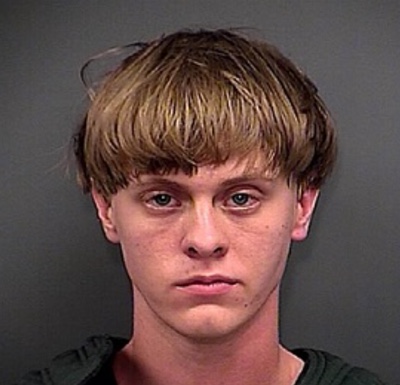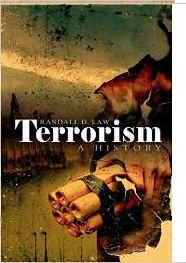Dylann Roof Was No Lone Madman

Last Wednesday, a violent racist struck in South Carolina in a heinous terrorist attack. Regardless of the banter back and forth across the aisle, make no mistake about it. Dylann Roof is a terrorist.
Since then, many have simply refused to call Roof’s violence an act of terrorism. Indeed, to ignore his motives and ignore the nature of his violence might allow us some measure of comfort. It has let us to think that such an act is random, an accident of human psychology, an individual aberration. It can’t really be understood. It has no meaning. It’s not worth studying since it belongs to no larger pattern or history, except, perhaps, to the pattern of human fallibility.
 But
that attitude is, at best, willful ignorance. At worst, it reeks of
white privilege and racism.
But
that attitude is, at best, willful ignorance. At worst, it reeks of
white privilege and racism.
All of the hallmarks of terrorism are present in Roof’s massacre of nine innocents at the Emanuel African Methodist Episcopal Church. He embraced the hate-filled ideology of white supremacy – a doctrine every bit as vile, intolerant, and evil as the jihadism of ISIS – and documented it online with text and images.
Just before he attacked, Roof spoke to his victims: “I have come to kill black people.” He then left one person alive so that she could tell others what he had said and done – and instructed her to do so. When caught, he quickly gave a confession to the authorities in which he described his motives and made clear his goal of using his ill-gotten fame to publicize his hatred and intimidate his racial enemies.
Terrorism is essentially symbolic violence that seeks to sway people’s behavior; it goes after the few in order to intimidate the many. A bloody act only becomes terrorism per se when a community understands that it has been targeted. This is why the American public’s reaction to the Emanuel AME massacre has been muddled. Americans have responded with near universal revulsion, but there’s been much debate about the act’s meaning.
Many blacks – and sympathetic whites – have reacted to the massacre for what it is: an act of violence meant to terrorize and intimidate the African-American community. Meanwhile, many white, conservative pundits have downplayed the attack, speculating that it’s the act of a lone gunman, a troubled youngster, a madman. Revulsion yes, but a clear rejection of any symbolic meaning.
How can we navigate this minefield and make sense of this act of violence?
Let’s consider his target. Roof didn’t simply stumble into any public place and begin shooting. He made a deliberate choice, stating in his confession that he attacked a church in Charleston, a community hundreds of miles from his home, because of the city’s concentration of African Americans. Should we take it as coincidence that Emanuel AME Church is one of the oldest black churches in the South, its pastor a prominent figure, its roots deep in Charleston’s African-American community? When we combine Emanuel’s profile with Roof’s explicit views on race and history, it is clear that this Charleston landmark was a symbolically rich target, not a random one.
Moreover, we see all the making of a rational plan, however distasteful such a characterization appears to us: Roof wanted to strike at the heart of South Carolina’s black community, to communicate to all blacks that they are not welcome, to gain notoriety in order to advertise his message
Let’s also consider history, which is unfortunately filled with precedent.
The Ku Klux Klan was the most successful terrorist group in American history when it was active in the 1860s and 1870s. Southern white supremacists sought to regain through a terrorist campaign what they had lost in the Civil War and early Reconstruction.
After they won – and yes, the KKK won this struggle – Southern political elites re-established a system founded on white supremacy. They set up Jim Crow laws to restore blacks to a position of political, social, and economic subservience in the South, and the Klan and related groups used lynching to police that system.
Between 1877 and 1950, nearly 4,000 African Americans died at their hands, according to a recent study from the Equal Justice Initiative. And white supremacists used terrorism – culminating in the murder of four young girls in Birmingham, Alabama, in 1963 – to resist the Civil Rights Movement in the following decades.
Despite the Movement’s many triumphs, the haters and their hatreds haven’t gone away. The Internet and social media have given white supremacists new ways to congregate virtually. In fact, the election of President Obama, accelerating globalization, and transformational demographic change have led to the growth of old hate groups and the creation of new ones in recent years, as documented by the Southern Poverty Law Center.
Terrorism is an infection whose best disinfectant is bright sunlight. We – all Americans, left, right, white, black – need to face the painful truth of what happened in Charleston: Dylan Roof is the product of a long-established, widely-held American tradition of racial hatred. In other words, Roof is not alone. History shows us this quite clearly.
We dismiss Roof as simply a troubled kid – a lone madman – at our peril. Will we call out homegrown American violence as the terrorism that it is? As a nation, we have a long way to go in our quest to form a more perfect union, but this would be an appropriate step for today.